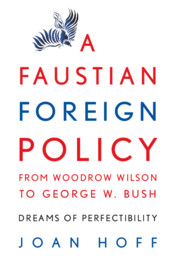Book contents
- Frontmatter
- Contents
- Introduction: Toward a Faustian Diplomacy
- 1 The United States Forms and Refines Its Diplomacy
- 2 The Faustian Impact of World War I on U.S. Diplomacy
- 3 The Faustian Aspects of Prosperity, Depression, and War
- 4 Faustian Aspects of U.S. Cold War Foreign Policy
- 5 Cold War Transformation of the American Presidency
- 6 The United States Adrift in the Post–Cold War World
- 7 Flaunting Faustian Foreign Policy
- Epilogue: The Legacy of George W. Bush
- Notes
- Bibliography
- Index
2 - The Faustian Impact of World War I on U.S. Diplomacy
Published online by Cambridge University Press: 18 August 2009
- Frontmatter
- Contents
- Introduction: Toward a Faustian Diplomacy
- 1 The United States Forms and Refines Its Diplomacy
- 2 The Faustian Impact of World War I on U.S. Diplomacy
- 3 The Faustian Aspects of Prosperity, Depression, and War
- 4 Faustian Aspects of U.S. Cold War Foreign Policy
- 5 Cold War Transformation of the American Presidency
- 6 The United States Adrift in the Post–Cold War World
- 7 Flaunting Faustian Foreign Policy
- Epilogue: The Legacy of George W. Bush
- Notes
- Bibliography
- Index
Summary
There can be no question of our ceasing to be a major power. The only question is whether we can refuse the moral leadership that is offered us, whether we shall accept or reject the confidence of the world…. The stage is set, the destiny is disclosed. It has come about by no plan of our conceiving, but by the hand of God who led us into this way…. It was of this that we dreamed at our birth. America shall in truth show the way.
Woodrow Wilson, presenting the Versailles Peace Treaty to the U.S. Senate, July 10, 1919Although Woodrow Wilson initially urged the country to be “impartial in thought as well as in action” in 1914, by the time the United States finally entered the First World War in 1917 he had failed to steer the country on a neutral course. The country accepted the president's idea that the United States should remain neutral when war broke out in Europe in 1914. Yet Wilson contradicted himself about what it meant for the United States to practice neutrality. In doing so, he led the country into that conflict on the highest moral, if unrealistic, grounds and reinforced the Faustian substructure of American diplomacy that would remain in place for the remainder of the twentieth century and into the twenty-first.
- Type
- Chapter
- Information
- A Faustian Foreign Policy from Woodrow Wilson to George W. BushDreams of Perfectibility, pp. 45 - 67Publisher: Cambridge University PressPrint publication year: 2007



